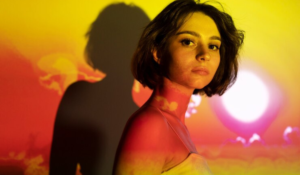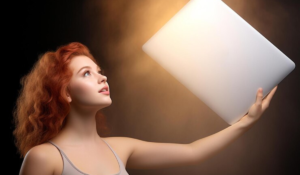What is Rembrandt Lighting and How to Use It for Portrait Photos

The Rembrandt lighting technique creates a dramatic and mysterious mood with its interplay of light and shadow. Both filmmaking and portrait photography use this style, named after Dutch master painter Rembrandt Harmenszoon van Rijn.
Rembrandt Lighting: Its Origins and Naming
Cecil B. Demille coined Rembrandt lighting in Hollywood in the 20th century for the production of “The Warrens of Virginia.” Rembrandt lighting refers to the strategic placement of light to produce dramatic effects. Demille’s use of the term “Rembrandt lighting” underscored its dramatic impact, which led to its widespread adoption.
Lighting characteristics of Rembrandt
A Rembrandt lighting arrangement involves directing light from a 45-degree to 60-degree angle to the side, about 30 degrees above the subject’s face. On one side of the subject’s face, this positioning creates a triangular patch of light known as the Rembrandt patch. An aesthetic of formality and timeless is achieved through the use of depth, texture, and mood.
Rembrandt Lighting Setup
Typically, one light source is positioned to the side and above the subject. In order to achieve soft, diffused lighting, softboxes and beauty dishes are commonly used, while grids enhance dramatic effects by controlling light spill.
Adaptations and variations
The lighting in Rembrandt can be adjusted according to the mood and composition desired. Portrait styles can be varied by using broad lighting (light facing the camera) or short lighting (shadow facing the camera). You can add hair lights for additional definition without compromising the mood of the image.
Considerations and applications
The Rembrandt lighting system provides flexibility in framing and composition for both close-ups and full-length portraits. In order to achieve desired effects and tailor lighting to individual subjects, photographers experiment with light placement and camera angles. In order to create visually striking portraits, photographers need to understand the principles of Rembrandt lighting.
In conclusion
Creating evocative and captivating portraits requires a mastery of Rembrandt lighting. Photographers can elevate their imagery by learning the techniques and nuances of this lighting style and convey depth, emotion, and resonance in their portraits.
Setting up Rembrandt Lighting
In Rembrandt lighting, a single light source is positioned at a 45-degree angle from the subject, approximately 5 feet away. A light source is positioned about two feet above eye level and angled downward slightly towards the side of the face further from the camera. A test shot is recommended to achieve the desired balance of light and shadow, creating a dramatic and contrasted look.
Reflectors and fill lights
To soften the lighting effect and provide additional illumination to the model’s face, reflectors can be added. Fill lights, set at half the key light’s intensity, fill in high-contrast shadows and enhance the model’s features.
Rembrandt Lighting Settings and Locations
For precise control over lighting conditions, Rembrandt lighting is best suited for controlled studio environments. The studio setup can be easily recreated with markers, which saves time and ensures consistency.
Rembrandt Lighting Tips
-
Focus points can be precisely controlled with spot meters, resulting in dramatic silhouette compositions.
-
Create different negative space effects and ratios by experimenting with multiple light sources and diffused light.
-
To master Rembrandt lighting and its ability to convey various moods and aesthetics, practice capturing yourself or models.
-
Invert triangles of light should be placed and sized according to traditional conventions on the subject’s cheek.
-
To bring out subtleties in an image, shoot in RAW format to preserve maximum detail.
-
Rembrandt lighting can accentuate certain facial features and convey different emotions, depending on the facial shape and occasion.
The Rembrandt lighting technique provides photographers with a versatile and effective tool for creating captivating portraits. Rembrandt lighting continues to be a cornerstone of portrait photography because of its rich history and timeless appeal.



